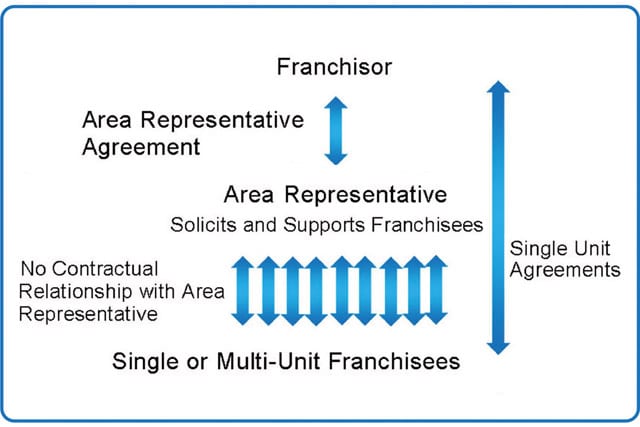The various types of franchise relationship structures and how they function, from single-unit and multi-unit franchising, to master franchising and area representatives, as well as other franchise options.
By Michael Seid, Managing Director, MSA Worldwide
The Various Types of Franchise Investments
It is important to understand, first, that franchising is simply a method of expansion and distribution.
- Manufacturers use franchising to bring their products to market using a “captured” downstream distribution system – this is called Traditional Franchising.
- Other companies, like McDonald’s or Marriott, use franchising to expand their brands by allowing others to deliver their products and services to the public and, different than Traditional Franchising, also define a system of delivery that the franchisee is required to follow – this is called Business Format Franchising.
In Traditional Franchising, the manufactured product is central to the franchise; in Business Format Franchising, the system of delivering the product or service takes center stage.
The franchise relationship is based on a contract between the franchisor and franchisee; the relationship is detailed in the Franchise Agreement, other licenses, and in other documents, primarily the system’s Operations Manual(s). Franchising is not a partnership. There is no fiduciary relationship between a franchisee and a franchisor. A franchisor and franchisee share a common brand; although interdependent with each other, they are independent businesses that are really in different businesses. The franchisee sells the products and services as specified by the franchisor; the franchisor is in the business of growing, managing and supporting their franchise system.
Franchising can be a wonderful way to become a business owner, and a wide variety of opportunities are available.
As you begin to explore either becoming a franchisor or franchisee, it is important for you to understand the variety of structures used in franchising today.
Single-Unit Franchises
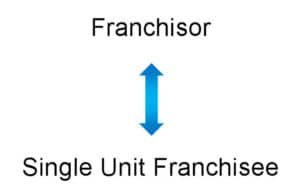 A single-unit or direct-unit franchise is where a franchisee invests in the right to operate one location or branded business.
A single-unit or direct-unit franchise is where a franchisee invests in the right to operate one location or branded business.
This is the oldest and simplest form of the franchise relationship.
Owning and operating one franchised location is the classic “mom and pop” structure used in franchising and, until recently, was the most common type of relationship found.
While single-unit franchising is still very common and can be a wonderful way to invest in business ownership, it does have some weaknesses for franchisors:
- As each location requires a new franchise, franchise system growth may be slower than multi-unit franchising, and the cost of providing services to the franchise system may be more costly because each unit has to be supported individually.
- There are more franchises to work with and those franchisees may have less capital and be more wary of taking business risks than larger multi-unit franchisees.
Multi-Unit or Area Developers
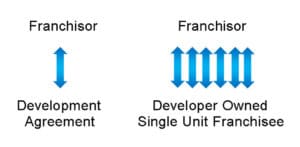 Multi-unit development is quite common today in franchising. It is estimated that over 50% of franchised locations are owned by people that have more than one location.
Multi-unit development is quite common today in franchising. It is estimated that over 50% of franchised locations are owned by people that have more than one location.
Multi-unit developers are granted the right and the obligation to a set number of locations, during a fixed period of time, and generally in a defined geographic territory.
Development of multiple units differs from how a single-unit franchisee may acquire additional locations; in addition to signing a franchise agreement, multi-unit franchisees sign a development agreement at the commencement of the relationship. The area development agreement gives the right and the obligation to open multiple locations, and obligates the franchisor to allow them to complete a development schedule. Each franchise established by a multi-unit developer will have its own separate franchise agreement, as the development agreement is not a franchise agreement.
If a multi-unit developer fails to meet their development schedule, the franchisor typically has the right to cancel the development agreement and keep the area development fee that is paid up front to the franchisor. Most often the multi-unit developer will still be allowed to continue to operate as a franchisee the locations that they have established, as long as they are in compliance with those individual unit agreements. In most multi-unit development agreements the developer will pay the franchisor a fee for the rights granted in the development agreement; that fee is usually applied on a pro-rata basis to each franchise fee that comes due.
This type of relationship can have significant benefits for both the franchisor and the multi-unit franchisee:
- Since the developer is opening more than one location, the cost for the franchisor to find franchisees is lower on a per-unit basis.
- Because there are fewer franchisees to service, the per-unit cost of serving a multi-unit franchisee is generally lower on a per-unit basis.
- The multi-unit developer allows the franchisor to have more controlled and planned growth.
- The multi-unit developer can achieve market critical mass faster than the franchisor can do on a single-unit basis.
- Multi-unit developers may be able to shift personnel between locations when required, resulting in better utilization of staff, and may be able to combine certain operations such as creating a commissary to make the business more efficient and lower the cost of operations.
- Multi-unit developers may combine purchases to save on the cost of goods and freight, and may have a central warehouse to lower their retail location footprint.
Master Franchising
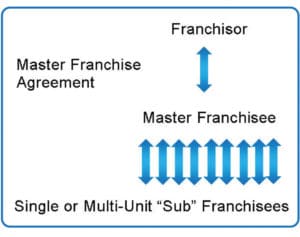 A master franchise relationship can look very similar to a multi-unit development structure but has one significant difference. Under a master franchise agreement, in addition to having the right and obligation to open and operate a number of locations in a defined area, the master franchisee also has the right and the obligation to offer and sell franchises to other people looking to become franchisees of the system. The master franchisee becomes the franchisor in their market area.
A master franchise relationship can look very similar to a multi-unit development structure but has one significant difference. Under a master franchise agreement, in addition to having the right and obligation to open and operate a number of locations in a defined area, the master franchisee also has the right and the obligation to offer and sell franchises to other people looking to become franchisees of the system. The master franchisee becomes the franchisor in their market area.
The master franchisee will generally be required to own and operate at least one or two locations themselves but may be allowed to sell those units to new franchisees at some point in time if they choose to do so.
When a master franchisee signs the master franchise agreement, they generally pay a master franchise fee to the franchisor and then collect a unit franchise fee from each franchise recruited into their system. The royalty they collect and the unit franchise fees they charge are typically shared with the franchisor; the percentage may vary.
Of all the types of franchising relationships, the master franchise relationship is the most complex, because of the agreement, and the terms of the agreement that generally have some shared responsibilities in support of the unit franchisee.
Each master franchisee will be required to prepare their own Franchise Disclosure Document, and if they are in a state that requires registration or filing, meet those requirements as well.
Master franchising is less popular in the United States today than it was in years past; however, it’s still the most prevalent method used by U.S. franchisors entering other countries.
Area Representatives
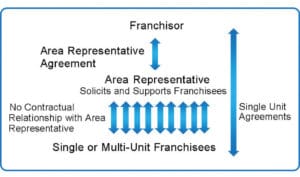 An area representative relationship looks very much like a master franchise relationship, with one major distinction. The area representative does not enter into any agreement with the unit franchisees. The unit franchisees sign a franchise agreement with the franchisor directly.
An area representative relationship looks very much like a master franchise relationship, with one major distinction. The area representative does not enter into any agreement with the unit franchisees. The unit franchisees sign a franchise agreement with the franchisor directly.
The area representative is, in reality, only a commissioned franchise salesperson and also the commissioned field support person for the franchisor in a geographic area. The area representative pays the franchisor a fee to enter into the relationship and shares with the franchisor the franchise fees and royalties paid by the franchisees in their territory. The area representative provides the franchisees in their territory some opening and continuing support and, like the master franchise, some of that support provided may be shared with the franchisor.
As with multi-unit and master franchise relationships, the area representative agrees to establish a specific minimum number of units, during a specified time period, in a defined territory. The difference between a master franchise relationship and an area representative is that the master franchisee signs an agreement with each sub-franchisee, while the area representative does not. The area representative also does not need to create or register their own Franchise Disclosure Document.
Other Franchise Options
There are other franchise structures used less frequently in franchising:
A conversion franchise is a relationship established with an existing independent operator, in the same general business as the franchise system, that agrees to sign a franchise agreement and convert their business into a franchise.
Non-traditional locations are those generally found in mass gathering locations such as airports, train stations, hospitals, college campuses, sports stadiums, ballparks, food courts, portable kiosks in parks, etc. These are the types of locations where customer traffic is generated by the other activities in the host facility: few people go to a baseball game just to buy a hot dog, but there are a lot of hot dogs sold during a ball game. Also included in this category are host locations such as convenience stores and big box retailers.
Existing franchises: One method of becoming a franchise that I personally like is buying an existing location from the franchisor or one of their franchises that want to exit the system. There are several advantages to buying a “used” franchise:
- You are in business faster, because you don’t have to find the location or work through constructing and equipping the business.
- Bank financing may be easier because the business is already up and running.
- The franchisor or the current owner may be willing to help you finance the location.
- The seller may be motivated to leave the business.
- You’re buying a business that is currently operating, has existing customers, and has an established cash flow.
- You know what the performance of the operation is and can base your investment and operating decisions on facts rather than projections.
- The location may have trained staff and management.
When buying an existing franchise, you need to conduct standard due diligence; you don’t want to buy a franchise if the original franchise can’t make a go of the location and the location just isn’t economically viable. These “opportunities” need to be examined carefully. Don’t assume that you’re a smarter or better operator than the existing franchise. Also, make certain that the franchise system you are joining does not have a high turnover percentage, as that may indicate that the system offers you little chance for success. When considering an existing franchise, always ask how many owners have run the operation before you negotiate a purchase price or sign any agreement.
Do you have questions about franchising your business?
MSA Worldwide provides expert guidance on building a successful and sustainable franchise business. Contact us today for a complimentary consultation.




